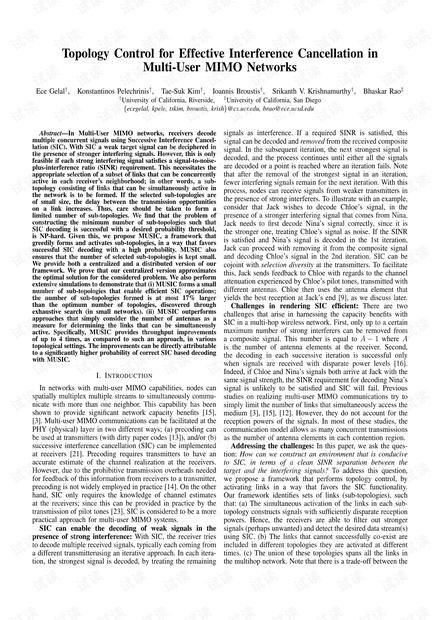Interference Cancellation in Multi-User MIMO Networks
阐述很详细,适合研究生。 Abstract—In Multi-User MIMO networks, receivers decode multiple concurrent signals using Successive Interference Cancellation (SIC). With SIC a weak target signal can be deciphered in the presence of stronger interfering signals. However, this is only feasible if each strong interfering signal satisfies a signal-to-noiseplus- interference ratio (SINR) requirement. This necessitates the appropriate selection of a subset of links that can be concurrently active in each receiver’s neighborhood; in other words, a subtopology consisting of links that can be simultaneously active in the network is to be formed. If the selected sub-topologies are of small size, the delay between the transmission opportunities on a link increases. Thus, care should be taken to form a limited number of sub-topologies. We find that the problem of constructing the minimum number of sub-topologies such that SIC decoding is successful with a desired probability threshold, is NP-hard. Given this, we propose MUSIC, a framework that greedily forms and activates sub-topologies, in a way that favors successful SIC decoding with a high probability. MUSIC also ensures that the number of selected sub-topologies is kept small. We provide both a centralized and a distributed version of our framework. We prove that our centralized version approximates the optimal solution for the considered problem. We also perform extensive simulations to demonstrate that (i) MUSIC forms a small number of sub-topologies that enable efficient SIC operations; the number of sub-topologies formed is at most 17% larger than the optimum number of topologies, discovered through exhaustive search (in small networks). (ii) MUSIC outperforms approaches that simply consider the number of antennas as a measure for determining the links that can be simultaneously active. Specifically, MUSIC provides throughput improvements of up to 4 times, as compared to such an approach, in various topological settings. The improvements can be directly attributable to a significantly higher probability of correct SIC based decoding with MUSIC. ### 干扰消除在多用户MIMO网络中的关键技术与应用 #### 一、研究背景与意义 在现代无线通信系统中,多用户多输入多输出(Multi-User Multiple-Input Multiple-Output, MU-MIMO)技术因其能显著提高频谱效率而备受关注。MU-MIMO系统允许多个用户同时共享相同的无线资源,从而提高了网络容量和频谱效率。然而,在这样的网络环境中,来自不同用户的信号可能会相互干扰,这种现象被称为多址干扰(Multiple Access Interference, MAI)。为了解决这个问题,研究人员提出了一种名为“逐次干扰消除”(Successive Interference Cancellation, SIC)的技术。 #### 二、逐次干扰消除技术概述 **逐次干扰消除(SIC)**是一种有效的方法,用于在多用户MIMO网络中处理干扰信号。其基本思想是在接收端解码接收到的多个信号时,首先解码最强的信号并从中减去该信号的影响,然后依次解码其余信号。这种方法能够使较弱的目标信号在存在较强干扰信号的情况下被成功解码。 为了实现成功的SIC解码,每个较强的干扰信号必须满足一定的信噪比加干扰比(Signal-to-Noise-plus-Interference Ratio, SINR)要求。这意味着需要适当选择每个接收器邻域内可以同时活跃的一组链路,即形成一个子拓扑结构。如果所选的子拓扑太小,则会增加传输机会之间的延迟。因此,需要谨慎地构造有限数量的子拓扑,以确保高效的SIC操作。 #### 三、构建子拓扑的挑战与解决方案 构建最小数量的子拓扑结构,使得SIC解码能够在期望的概率阈值下成功的问题是NP难问题。为了解决这一难题,研究人员提出了MUSIC框架。MUSIC框架通过贪婪的方式形成并激活子拓扑,以提高SIC解码的成功概率,并确保选择的子拓扑数量保持较小。 **MUSIC框架的关键特性:** 1. **中心化版本与分布式版本:**提供了中心化和分布式两种实现方式。中心化版本能够近似最优解,而分布式版本则更适合大规模网络环境。 2. **性能评估:**通过广泛的模拟实验表明,MUSIC能够形成数量较少但效率较高的子拓扑,与通过简单考虑天线数量来确定同时活动链路的方法相比,MUSIC能够提供高达4倍的吞吐量提升。 3. **优化SIC解码概率:**MUSIC确保了较高概率的正确SIC解码,这是其性能改善的主要原因。 #### 四、MUSIC框架的具体实现 **1. 子拓扑的形成机制:**MUSIC采用贪婪策略来选择子拓扑。该策略首先识别出网络中最关键的链路集合,这些链路对于维持整个网络的连通性和性能至关重要。接着,根据链路的SINR要求和其他相关因素,逐步构建子拓扑。 **2. 性能评估与优化:**为了验证MUSIC的有效性,研究人员进行了大量的仿真测试。结果表明,MUSIC形成的子拓扑数量最多只比通过穷举搜索找到的最佳拓扑数量高出17%,特别是在小型网络中表现更佳。 **3. 与其他方法的比较:**传统方法往往仅考虑天线数量作为衡量标准来确定哪些链路可以同时激活。相比之下,MUSIC不仅考虑了天线数量,还综合考虑了链路间的相互干扰以及SINR要求等因素,从而实现了更高的系统吞吐量和更稳定的性能。 #### 五、结论与展望 MUSIC框架为解决多用户MIMO网络中的干扰问题提供了一种有效的解决方案。通过构建高效且数量有限的子拓扑结构,MUSIC不仅提高了系统的整体性能,还确保了较低的延迟和较高的SIC解码成功率。未来的研究方向可能包括进一步优化算法以适应更大规模的网络环境,以及探索新的技术手段以减少计算复杂度和提高算法的鲁棒性。

- 粉丝: 2
- 资源: 16
 我的内容管理
展开
我的内容管理
展开
 我的资源
快来上传第一个资源
我的资源
快来上传第一个资源
 我的收益 登录查看自己的收益
我的收益 登录查看自己的收益 我的积分
登录查看自己的积分
我的积分
登录查看自己的积分
 我的C币
登录后查看C币余额
我的C币
登录后查看C币余额
 我的收藏
我的收藏  我的下载
我的下载  下载帮助
下载帮助

 前往需求广场,查看用户热搜
前往需求广场,查看用户热搜最新资源


 信息提交成功
信息提交成功